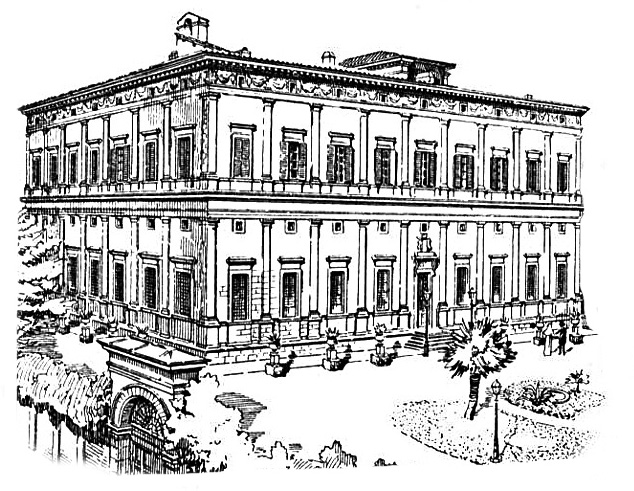

LE DELIZIE OR “THE DELIGHTS” was the original name of this villa, known back in Renaissance days as the best party house in Rome. It was built by Agostino Chigi, banker to the popes, aka the Richest Man in the World. Way before Chigi got to it, on the same site in 44 B.C., Cleopatra had carried on with Julius Caesar in a villa the emperor had here.
Chigi was a generous patron of the arts, so in 1506 he called in the top architect (Baldassarre Peruzzi) and best painters to create luscious gardens and a villa packed with frescos of mythological love scenes to inspire his guests. Spectacles with singers and dancers were staged here, followed by opulent banquets. For the grand finale, Chigi had his servants toss his used china and silverware into the Tiber. Little did his guests know he kept a net down there to catch it all.
The stars of Chigi’s parties were Rome’s adored courtesans. These beautiful ladies, called “honest prostitutes,” in addition to providing their expected services, could recite classical poetry at the drop of a hat and serenade their admirers with lutes or violins. They were treated well by Rome’s many wealthy bachelors, who ranged from merchant traders to priests. Like movie stars, when courtesans rode through the streets in their fancy carriages, people would run out to gawk at their elegant get-ups, jewels, and hairstyles.
Imperia, one of Rome’s most famous courtesans, was a favorite of Chigi’s—he planned on living with her in this villa when he first decided to build it. The painter Raphael, who also spent quality time with Imperia, had her model for one of the first frescos you’ll see here in the Loggia of Galatea.
The image of the half-naked sea nymph (surprisingly muscular and fleshy) is a scene from a Greek myth that began with the Cyclops Polyphemus falling madly in love with Galatea. Unfortunately for Polyphemus, Galatea fell in love with a mortal shepherd, Acis. When Polyphemus saw the two of them cavorting, he flipped out and threw a boulder at the couple, killing Acis. The blood of Galatea’s dead lover turned into a river that she rides away on in this painting, triumphantly escaping Polyphemus.
Raphael’s model Imperia was not so triumphant. The courtesan had many men besides Chigi, and fell in love with one of them. When he tired of her, Imperia feared she was losing her beauty, and at the age of twenty-six swallowed poison and died. The exact date of her suicide was August 15 (coincidentally, the celebration of Mary’s Assumption into heaven). There was a huge storm in Rome that night, with folks in the city saying Jupiter had thundered down to take away their beloved beauty.
Imperia’s image appears again upstairs in this villa, where the artist Sodoma frescoed Chigi’s bedroom with scenes from the life of Alexander the Great. There The Wedding of Alexander and Roxane reeks with sexual anticipation, as Roxane’s clothes are tugged at by putti and Alexander stands awaiting his bride.
Chigi and Imperia had broken up before her suicide, and he’d gone to Venice and gotten himself another courtesan, Francesca. The couple moved in here and, after having four children, the Pope insisted Chigi marry Francesca. Their wedding was one of the biggest bashes ever held in the villa, with Pope Leo and twelve cardinals in attendance.
For all the great parties at Le Delizie, guests would enter through the Loggia of Psyche, the villa’s most beautiful setting, which originally opened to the gardens and wasn’t enclosed like it is today. Raphael designed it, but had no time to paint it, as he was busy with other jobs and his romance with Margherita Luti, a baker’s daughter who lived in the neighborhood. His students completed it, bringing in elements of nature with ornamentation of lush greenery, flowers, and fruit surrounding frescos that tell the love story of Amore and Psyche. Here’s a myth that fit right in with the Renaissance philosophy of joining the Divine (Amore) with the Mortal Mind/Soul (Psyche). The goddess Venus is of course involved, and after many trials, the main characters are united in a marriage celebration painted on the ceiling.
After Chigi’s death, the Farnese family bought Le Delizie, renamed it Farnesina, and planned on connecting it to their palazzo near the Campo dei Fiori. The proposed bridge was never completed, but part of it forms that beautiful, dripping-with-vines archway you’ll see over the Via Giulia.
Villa Farnesina: Via della Lungara 230, open Monday-Saturday, 9-2 (www.villafarnesina.it)

Golden Day: Visit the Farnesina, then lunch at da Gildo to enjoy simple Roman specialties on the outside terrace, such as vignarola, vegetable stew, a springtime treat. (Via della Scala 31, 06 580 0733, closed Thursday)
TIP: This is one of the few museums in Rome that is open on Monday.
RECOMMENDED READING
Raphael: A Passionate Life by Antonio Forcellino